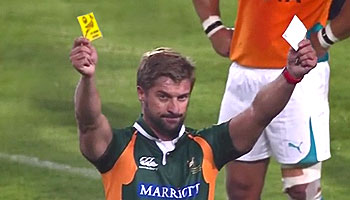
There’s been a fair bit of confusion since the introduction of the new White Card in Super Rugby. Last weekend we saw one issued for a tip-tackle, so here’s a quick look at that, as well as an explanation of how the process works.
The new white card system is being trialled in this year’s tournament in an effort to streamline and simplify the citing procedure. There are no changes to the issuing of the standard yellow and red cards, but the white card can now be used to indicate that further inspection may be required.
So if a referee suspects foul play, or sees something but isn’t quite sure on how to judge it in the heat of the moment, he can pass it on to the citing commisioner, who will then deal with it later on. This was the case with Cheetahs center Andries Pretorious last weekend, who made a dangerous tackle on Wickus Van Heerden of the Lions.
A yellow card was given, and whether or not it should have been a straight red card was to be determined with the showing of the white card. Strauss accepted a guilty plea within the stipulated four-hour time period, thus guaranteeing him a lesser sentence than if it went to a full judiciary.
He was given a two week suspension after the tackle was deemed not intentional. Other issues were also taken into account and the decision was reduced or ‘discounted’ by two weeks for remorse, an early plea, and an admission of guilt. He also apologised personally to Van Heerden, who had ‘residual neurological symptoms assumed to be from bruising.’
There are also other new elements in the citing procedure, such as an Off-Field Yellow Card. Two of these were actually issued this weekend, with Tristan Moran and Jason Eaton, both of the Hurricanes, being given off-field yellow cards after review of two seperate incidents. One was for a shoulder charge, and the other for stamping.
An off-field yellow card can be issued when the Citing Commisioner sees an act of foul play that is considered close to, but not quite, a red card. These have no immediate affect, but get logged on the player’s disciplinary record, much in the same way as an on-field yellow card would.
What do you think of the new concept, and do you think the IRB should take it on board in future?
Sign In